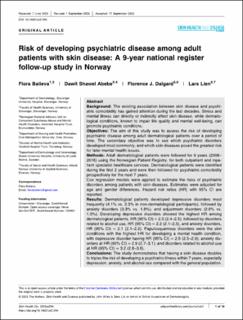Risk of developing psychiatric disease among adult patients with skin disease: A 9-year national register follow-up study in Norway
Peer reviewed, Journal article
Published version
Permanent lenke
https://hdl.handle.net/11250/3105123Utgivelsesdato
2023Metadata
Vis full innførselSamlinger
Originalversjon
10.1002/ski2.294Sammendrag
Background: The existing association between skin disease and psychiatric comorbidity has gained attention during the last decades. Stress and mental illness can directly or indirectly affect skin disease, while dermatological conditions, known to impair life quality and mental well‐being, can promote psychiatric conditions. Objectives: The aim of this study was to assess the risk of developing psychiatric disease among adult dermatological patients over a period of time. The secondary objective was to see which psychiatric disorders developed most commonly, and which skin diseases posed the greatest risk for later mental health issues. Methods: Adult dermatological patients were followed for 9 years (2008– 2016) using the Norwegian Patient Registry, for both outpatient and inpatient specialist healthcare services. Dermatological patients were identified during the first 2 years and were then followed for psychiatric comorbidity prospectively for the next 7 years. Cox regression models were applied to estimate the risks of psychiatric disorders among patients with skin diseases. Estimates were adjusted for age and gender differences. Hazard risk ratios (HR) with 95% CI are reported. Results: Dermatological patients developed depressive disorders most frequently (4.1% vs. 2.3% in non‐dermatological participants), followed by anxiety disorders (3.3% vs. 1.8%), and adjustment disorders (2.6% vs. 1.5%). Developing depressive disorders showed the highest HR among dermatological patients, HR (95% CI) = 2.5 (2.4–2.5), followed by disorders related to alcohol use, HR (95% CI) = 2.2 (2.1–2.5), and anxiety disorders, HR (95% CI) = 2.1 (2.1–2.2). Papulosquamous disorders were the skin conditions with the highest HR for developing a mental health condition, with depressive disorder having HR (95% CI) = 2.6 (2.5–2.9); anxiety disorders at HR (95% CI) = 2.9 (2.7–3.1); and disorders related to alcohol use at HR (95% CI) = 3.2 (2.8–3.6). Conclusions: The study demonstrates that having a skin disease doubles to triples the risk of developing a psychiatric illness within 7 years, especially depression, anxiety, and alcohol use compared with the general population.

